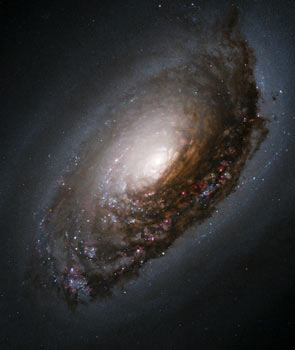The stars rotate the galaxy M64 in a clockwise direction. The gas in the outer regions rotates in the opposite direction. Hubble reveals new details about the strange galaxy

A collision between two galaxies left a merged star system with an unusual appearance, and also a bizarre internal motion system. Messier 64 (M64) includes a thin band of light-absorbing dust in front of the galaxy's bright nucleus, a phenomenon that has been nicknamed the "black eye galaxy" or the "evil eye galaxy".
This image of M64 was taken by the Hubble Space Telescope's Planetary Camera #2 in 2001. The color image is a composite recently prepared by the Hubble Heritage team from images taken with four different color filters. These filters isolated blue light and near-infrared light, along with red light emitted from hydrogen atoms and green light emitted from Strongmen y.
M64 is located in the northern star system Haaret Bernica, and is 17 million light years away from us. At first glance it looks like a normal swirling galaxy, quite similar to the Milky Way. As in most galaxies, all the stars in m64 rotate in the same direction - clockwise, as seen in the Hubble image.
However, studies conducted in the nineties of the 20th century led to the discovery that the interstellar gas in the outer regions of the galaxy moves in the opposite direction from the gas and stars in the inner parts. A strange thing indeed.
The astronomers believe that the gas rotating in the opposite direction appeared when M64 swallowed a galaxy that collided with it, probably over a billion years ago. The small galaxy has now been completely destroyed, but signs of a collision are present in the form of the contralateral motion of M64's outer gas layer.
Active production of new stars continues in the outer parts where the gas moving in the opposite direction collides. This is because the gas causes the compression of clouds of dust and gas and the process of star formation. In particular, hot blue stars that have just formed can be seen in the image, along with pink clouds of hydrogen gas glowing because they have been exposed to ultraviolet light from the newly formed stars.
For information on the website of the scientific center of the Hubble Space Telescope
